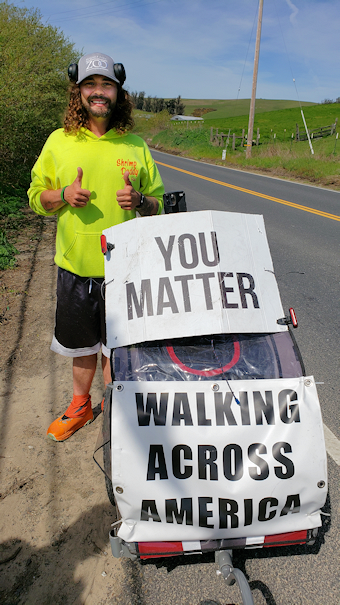Current e-Journal
-

April 2, 2024

Do
your people
really
matter?
In this week’s Systems Change Newsletter…
- Invitations and Announcements
- Catalytic Thinking Exercise: Making your work as humane as possible
- Resources to Further Your Practice
Invitations & Announcements:
Designing Equitable Hiring Practices via Catalytic Thinking
At our April Integrity conversation, we will continue designing equitable, inclusive, and joyful hiring and contracting processes by applying Catalytic Thinking. This has been such an exciting exploration so far, and it just keeps getting more so. Want to learn alongside us? Click now!
Catalytic Thinking Exercise:
Making your work as humane as possible
His name is Kyndal Ray Edwards, and he is walking across the U.S.
His purpose is simple: “To tell everybody that You Matter and We Do Recover!” As he meets people on his journey, he doesn’t ask for money; he asks for a hug or a handshake, or perhaps even to join in song. That most basic of needs — to be human with each other — is at the heart of his recovery from addiction.
While Kyndal Ray’s approach may be out of the ordinary, the connection at the heart of his recovery is intensely ordinary. Connecting is as chemically hard-wired into the reflexive areas of the human brain as fight-flight-flee. It is what makes us involuntarily cry at movies, or feel an almost physical hurt when a loved one is in pain. We are, quite simply, hard-wired to care about and for each other.
And yet so many systems we encounter in social change organizations are built upon just the opposite of that caring. That, of course, leads to all sorts of problems for leaders in nonprofits and social enterprises. As Hildy noted in a recent article, that list of problems includes…
“Burnout, turnover, morale, the need for team building. The ‘nonprofit workforce crisis’ we keep hearing about. Doing more with less. One person doing the work of 3 people, but still not getting paid enough for that one person to live their life with confidence. ‘Human Resource’ departments whose job is not at all about providing resources for humans, but is instead to protect the organization from those troublesome creatures...”
When these situations arise, logic would encourage us to re-design our systems, to be as supportive and nurturing of our humanity as possible. Unfortunately, we don’t do anything like that. We blame the victims, bringing in team building folks to “fix” our team members. We bemoan having to “deal with crap employees.” We complain about the next upcoming generation (a song as old as Socrates).
In a recent question posed by LinkedIn’s team, their AI bots were asked, “What do you do if burnout is causing philanthropy professionals to leave their jobs?” The AI’s answers (garbage in, garbage out) were about self-care and boundaries. Got a problem at work? It’s not the systems you work within – it’s YOU!
The questions of building a humane workplace are front of mind for us at Creating the Future these days, as our Integrity Conversations are all focused on designing equitable and supportive hiring practices (see the Invitations section above for more about that). As we explore what “good” would look like in these practices, it leads us to ask you…
What would it take for your organization’s work to be as human and humane as possible?
Try this:
Using the questions of Catalytic Thinking, you can either begin by asking about your entire workplace or you can ask those questions issue by issue. As long as you are asking the questions of Catalytic Thinking, your answers will lead you in the direction of being as humane and equitable as possible. That is the power of Catalytic Thinking!
To tackle the issues as they arise, practice asking about the conditions that would lead to more connection and support.
- First, who will be affected by whatever you are considering? What will it take for them to participate in this conversation – and to lead the direction you take?
- Whatever the issue at hand, what would humane, nurturing, supportive practice look like? What would this function look like if it were prioritizing the health and joy of our people? What would it look like if this function were bringing out the best in our people?
- What would make that goal a reality? What would people need to have? What would they need to see or experience? What would they need to be assured of?
If you want to tackle ALL your workplace systems at once, to address the underlying culture at the heart of those individual issues, the same questions apply. The answers will lead you back to all the individual functions, and you will have the context of the whole to touch back on.
The bottom line is that you don’t have to take nearly as many precautions to protect your organization from the harm employees might do if you are doing all you can to bring out the best in each person. (And if you’re skittish about trying this at work, try it with your kids first. See what happens when instead of nagging and punishing, you find ways to make things happen that bring out the best in whosever turn it is to take out the trash…)
The power of Catalytic Thinking is the simple fact that anyone, regardless of position, has the power to ask a question. Once we realize that the systems we find ourselves in are simply the answers to questions, we begin to see that when we change the questions we are asking and answering, we really can change the world.
Resources to Further Your Practice:
- READ: When it comes to humane practices with a price tag, how will you pay for it? Hildy’s article at Substack addresses that head on. Find out here…
- IMMERSE: Equitable Evaluation is about so much more than evaluation. It is about creating more humane, equitable practices for EVERYTHING we do. This whole journal is a treasure trove!
- LEARN: What would it take for your team members to listen for what is possible in each other, to support each other before conflict arises? Find out here…
Help Keep Our Programs Freely Available
Creating the Future’s eJournal is free. And there are no financial barriers to our classes – tuition is whatever folks can afford. Because we never want money to stand in the way of people learning.
If you value our content and our approach, please donate here – and please consider becoming a monthly supporter of our work.
eJournal Archives:
If you’re new to our eJournal, or just want to remind yourself of past practice exercises we’ve shared, check out our eJournal archives here.
SUBSCRIBE
to get this e-Journal
Creating the Future is a 501(c)(3) tax exempt organization in the U.S.A


